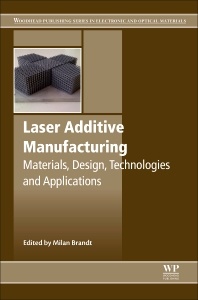Description
Laser Additive Manufacturing
Materials, Design, Technologies, and Applications
Woodhead Publishing Series in Electronic and Optical Materials Series
Coordinator: Brandt Milan
Language: English
Subjects for Laser Additive Manufacturing:
Keywords
3D cell model; 3D micro-/nanofabrication; 3D printing; 3-D printing; Additive manufacturing (AM)Ceramics; Additive manufacturing; Aeronautics; Aerospace industry; AlSi12Mg; Aluminium; Astronautics; Bare die; Biocompatibility; Bioprinting; Black box system; Cell printing; Ceramics; Computer-assisted design (CAD)Direct metal deposition (DMD)Homogenization design method (HDM)Laser cladding; Computer-assisted design; Cost structure; Cracking; Crystallization; Deep drawing; Defects; Degree of polymerization; Design for LAM; Design for manufacturing (DFM)Design guidelines; Differential scanning calorimetry; Digital manufacturing; Direct manufacturing; Directed energy deposition; Electrical conductive polymers; Embedded circuit; Embedded electronics; eses; Femtosecond laser direct writing; Flame retardants; Hausner ratio; Hybrid laser manufacturing; Indirect manufacturing; Interconnects; Intumescent flame retardants; LaBP; Laser additive manufacturing (LAM)Laser additive manufacturing; Laser beam; Laser direct write; Laser metal deposition; Laser sintering; Laser; Laser-assisted bioprinting; Laser-induced forward transfer; Lattice structures; Layer-laminated manufacturing; LDW; LIFT; Mechanical properties; Melt pool; Metal forming; Metallic and nonmetallic components; Microbattery; Microstructure; Multiphoton ablation; Multiwall carbon nanotube (MWNT)Nanographene platelet (NGP)Nylon 11; Negative coefficient of thermal expansion (NCTE)Solid free-form fabrication (SFF)Optimisation; Part candidates; Patient-specific design; Polyamide 11; Polymer nanocomposites; Postheating; Powder bed fusion process; Powder bed fusion; Powder bed; Powder nozzle; Preheating; Profitability; Prosth; Raman spectroscopy; Residual stresses; Scan count; Selective laser melting; Selective laser sintering (SLS)SMD; SMT; Surface roughness; Texture; Ti6Al4V; Tissue printing; Titanium; Trade-off methodology; Two-photon polymerization
498 p. · 15x22.8 cm · Hardback
Description
/li>Contents
/li>Biography
/li>Comment
/li>
Laser Additive Manufacturing: Materials, Design, Technologies, and Applications provides the latest information on this highly efficient method of layer-based manufacturing using metals, plastics, or composite materials. The technology is particularly suitable for the production of complex components with high precision for a range of industries, including aerospace, automotive, and medical engineering.
This book provides a comprehensive review of the technology and its range of applications. Part One looks at materials suitable for laser AM processes, with Part Two discussing design strategies for AM. Parts Three and Four review the most widely-used AM technique, powder bed fusion (PBF) and discuss other AM techniques, such as directed energy deposition, sheet lamination, jetting techniques, extrusion techniques, and vat photopolymerization. The final section explores the range of applications of laser AM.
Part One. Processes, technology and materials 1. Laser-aided direct metal deposition of metals and alloys 2. Powder bed fusion processes: An overview 3. Hybrid laser manufacturing 4. Surface roughness optimisation for selective laser melting (SLM): Accommodating relevant and irrelevant surfaces 5. Mechanical properties of Ti6Al4V and AlSi12Mg lattice structures manufactured by Selective Laser Melting (SLM) 6. Laser additive manufacturing of ceramic components: Materials, processes, and mechanisms 7. Powder bed fusion of polymers 8. Polymer nanocomposites for laser additive manufacturing 9. Laser additive manufacturing using nanofabrication by integrated two-photon polymerization and multiphoton ablation
Part Two. Design strategies and life cycle costs 10. Design for laser additive manufacturing 11. Modelling of laser additive manufactured product lifecycle costs
Part Three. Applications 12. Laser additive manufacturing of embedded electronics 13. Aerospace applications of laser additive manufacturing 14. Laser sintering of ceramic materials for aeronautical and astronautical applications 15. Laser additive manufacturing of customized prosthetics and implants for biomedical applications 16. Laser additive printing of cells 17. Additive manufacture of tools and dies for metal forming
- Provides a comprehensive one-volume overview of advances in laser additive manufacturing
- Presents detailed coverage of the latest techniques used for laser additive manufacturing
- Reviews both established and emerging areas of application




